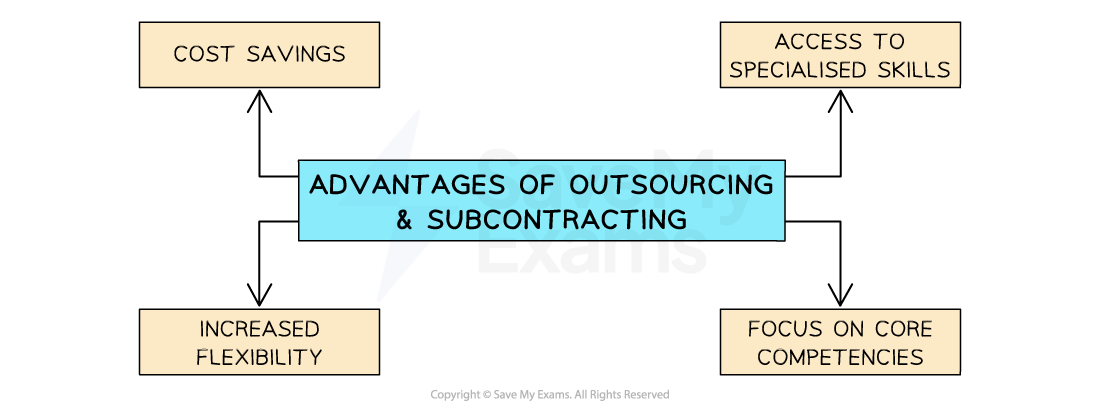Reorganising Production (DP IB Business Management) : Revision Note
Outsourcing & Subcontracting
Outsourcing is the process where a business delegates specific business activities (IT, customer support, HR etc) to external service providers
Businesses choose to outsource these functions to reduce costs, access specialised expertise, or focus on core competencies
Subcontracting occurs when specific parts of a larger project or contract are assigned to third-parties
The business remains responsible for the overall project or contract but certain components or tasks are delegated to other companies/individuals with specialised skills
Diagram: advantages of outsourcing and subcontracting

Cost savings
Businesses can often reduce expenses associated with operations such as hiring and training employees, maintaining infrastructure and managing IT systems
Access to specialised skills
External specialists have resources that the business lacks internally which allows it to benefit from the knowledge and experience of industry specialists as and when required
Increased flexibility
They can provide greater flexibility to scale their operations up or down based on demand fluctuations which is particularly valuable in industries with seasonal or unpredictable demand
Focus on core competencies
Businesses can concentrate their resources and efforts on their core competencies where they can add value
Limitations of outsourcing and subcontracting
Quality control
Using external providers makes it harder to ensure consistent quality and adherence to company standards
Loss of control
Handing direct control over those activities to others outside of the business may be risky. Companies must carefully select reliable partners and establish clear contractual terms to protect their interests
Data security and confidentiality
Sharing sensitive information outside of the business introduces potential risks to data security and confidentiality
Communication and cultural differences
Using global providers may result in language barriers or problems with time zone differences. Cultural differences may present communication challenges
Offshoring
Offshoring occurs when a business sets up operations in another country to carry out certain business processes so as to:
Take advantage of lower labour costs
Gain access to specialised skills
Expand into new markets
Common examples of offshoring practices include call centres in foreign countries, software development teams or manufacturing plants established in countries with cheaper labour
Evaluation of Offshoring
Advantages | Disadvantages |
|---|---|
|
|
Insourcing
Insourcing is where a business assigns tasks to individuals within the organisation which were previously outsourced
There are several reasons why businesses may choose to insource certain activities
Diagram: reasons for insourcing

Cost control
Insourcing can be a cost-saving strategy as it eliminates the need to pay external specialists
Quality control
A business retains direct control over the quality of work being produced and may find it easier to establish their own standards
Flexibility
It provides the business with greater flexibility to respond to changing business needs, so can adjust workflows and adapt to new challenges
Knowledge and skill retention
Businesses can develop specialised skills within their own workforce, which can also reduce the risk of intellectual property breaches
Reshoring
Reshoring occurs when a business brings back its production activities to its home country from abroad
It involves reversing the previous decision to offshore or outsource those activities to another country
There are several reasons why a company may choose to reshore its operations
Diagram: reasons to reshore

Cost considerations
The initial cost advantages of offshoring may reduce due to factors such as rising labour or transportation costs in the foreign country
Quality control
By reshoring, companies can have better control over the manufacturing processes and ensure higher quality control standards, which may lead to improved customer satisfaction
Intellectual property protection
By bringing manufacturing back to their home country, they can reduce the risk of intellectual property theft
Supply chain resilience
The COVID-19 pandemic highlighted the vulnerabilities of global supply chains when disruptions in transportation, logistics and international trade led to delays and shortages of critical goods
Reshoring reduces dependence on foreign suppliers
Market proximity
Can allow companies to be closer to their target markets, which can lead to faster delivery times, reduced transportation costs and improved responsiveness to customer demands

You've read 0 of your 5 free revision notes this week
Unlock more, it's free!
Did this page help you?

